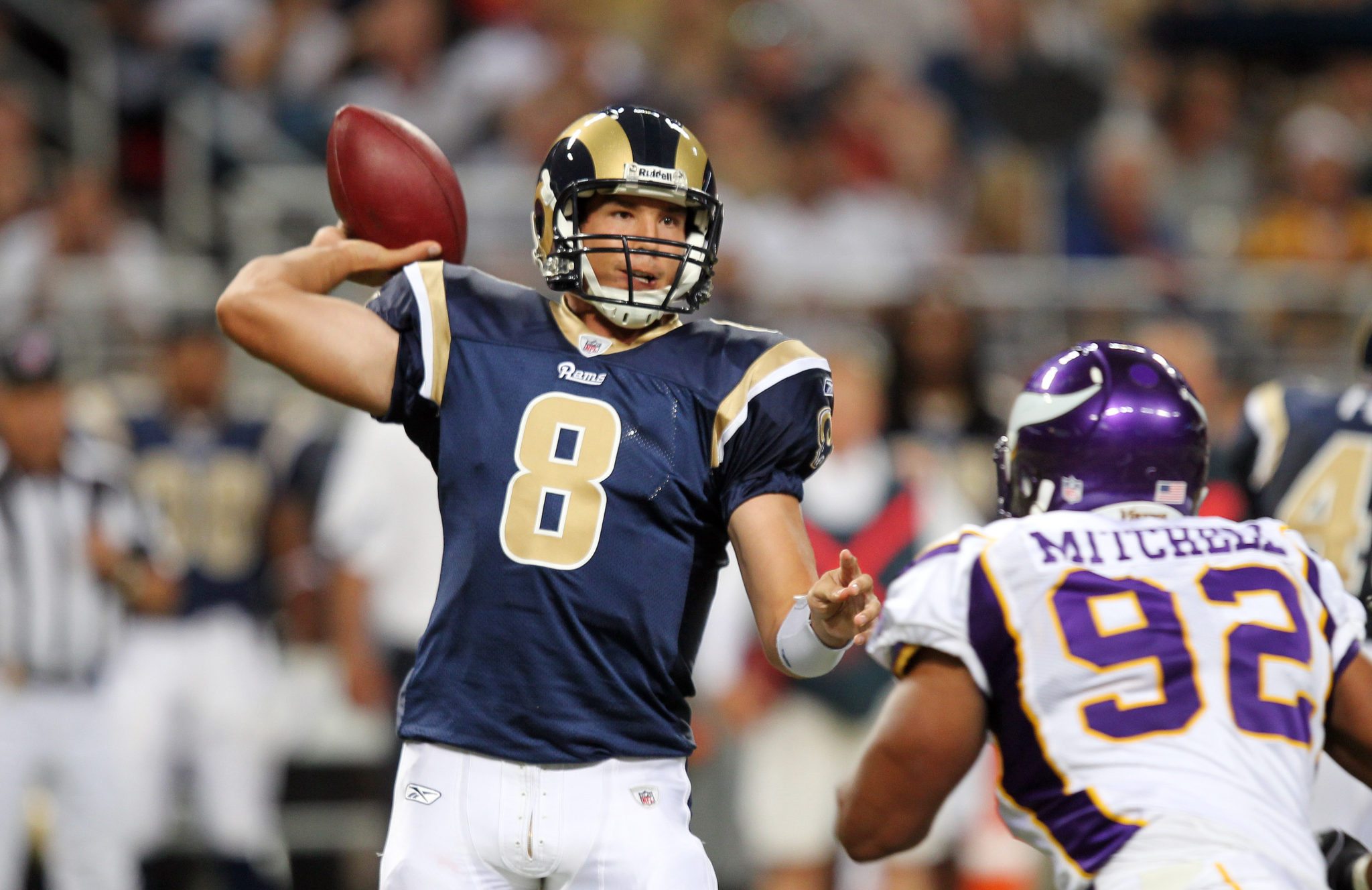Sam Bradford has been the target of criticism from many in Rams’ Nation, and from sports analysts. But while his career stats aren’t bad by any means, and before his unfortunate injury this year while on pace to set career highs, fans and analysts alike are getting impatient with him, and the young QB is running out of time to prove himself as the true franchise QB for a team that hasn’t had a winning season since 2003 (they went 8-8 in 2004).
Fans wonder when will be the year Bradford will finally show his full potential. That year has to be 2014. In a tough a division as the NFC West, there is no time to waste. It’s asking a lot for a player to have a great year after an ACL tear, but Adrian Peterson proved it’s possible.
Now, it’s Bradford’s turn.
Flashback to 2010. The Rams were without a doubt, the worst team in the NFL. The records in recent years proved it. But there was hope on the horizon. Coming off a 1-15 record, the team had drafted (with the #1 pick) a QB from Oklahoma named Sam Bradford. Although he did not throw at the combine due to injury, his skills were well known at OU, and was a very intelligent QB (He scored a 36 out of 50 on the Wonderlic test, higher than the average of 28.5)
Before the start of the 2010 season, Bradford signed a six-year, $78 million deal, which has $50 million of guarantees and has a maximum value of $86 million, which was the highest salary by a rookie ever. After a brief competition with A.J Feeley, Bradford was named the 2010 starter.
He lost in his first start by the score of 17-13 to the Arizona Cardinals. He threw three picks and only one touchdown in the game. He later became the first QB to win “Offensive Rookie of the Month” in two consecutive months (October, November). For the first time in years, the Rams’ looked like contenders for a division title. The season came down to a showdown at Seattle against the Seahawks in week 17, but the Rams fell to Seattle and missed the playoffs again. In his first season, he threw 18 TD’s and 15 INT’s, and threw for 3512 yards.
2011 was considered (and still is) to have been Bradford’s worst year overall. In 10 starts, he threw a mere 6 touchdowns while throwing six picks as well. His completion percentage was a low 53.3%. He only had one win, a week 10 victory at Cleveland, and the Rams finished 2-14 and seemingly took a huge step backward from the previous season. Rams fans grew irate, wondering if change was truly over the horizon. After 2012, Steve Spagnuolo and Billy Devaney were both fired, and the Rams would once again rebuild.
The following season, the Bradford-led Rams attempted to make a comeback from the previous year’s debacle. This time around, Bradford had a new head coach, Jeff Fisher, and new OC, Brian Schottenheimer. This season, the Rams started 3-2, which was the first time since 2004 they had a winning record, and only lost once in the entire division, a week 17 loss to Seattle. The Rams finished a respectable 7-8-1, a major improvement over 2-14 from the year before.
Still, it was Bradford’s third season, and the Rams had not had a winning record, and people kept wondering whether Bradford truly was the future of this franchise.
2013 had higher hopes than before, and Rams’ Nation was hoping for that long awaited playoff appearance. With a new set of receivers (along with some from the year before), and a new full-time starter in Daryl Richardson, the Rams were poised to make noise.
Bradford was having a career year, throwing 14 TD’s and only 4 picks, but the struggles were still there. At home against the 49ers on Thursday Night Football, the Rams played one of their worst games of the year in a heartbreaking loss. The run game could not get anything going (Richardson was eventually benched for rookie Zac Stacy) as boos could be heard from all around the Edward Jones Dome.
In week 7, Bradford’s season effectively ended when he suffered a torn ACL in a game against the Carolina Panthers. Once again, the Rams missed the playoffs, finishing 7-9. After Bradford’s injury, many of the Rams’ young stars began to break out, such as Stacy and Tavon Austin, and one wonders how a Bradford-Austin or Bradford-Stacy combo would work for the offense.
In four years in the NFL, Bradford has thrown over 11,000 yards, 59 TD’s and 38 INT’s, which is average stats for a QB, but many do not believe it is good enough. GM Les Snead has said time and time again Bradford is the franchise QB, and they have no intentions of drafting one in this year’s QB-heavy draft.
Bradford has shown how good of a QB he is, but he also has shown he still has a lot to improve on. But Bradford has been heavily invested by the Rams, and now that he is considered injury-prone (after his ACL tear), the Rams should focus on building a wall of strong blockers to protect him.
2013 had many issues: struggling running game until the emergence of Stacy, special teams’ miscues preventing the offense from gaining good field position, and issues within the secondary. Bradford isn’t all to blame, but yet, the blame is placed on him.
The Rams have invested a lot in the Oklahoma product because they believe in him being the quarterback St. Louis needs. But fans and media personalities alike have started to grow weary of him. 2014 is the year Bradford truly needs to establish himself as the franchise QB. One that can lead the Rams out of the decade-long playoff drought they have longed to climb out of.


